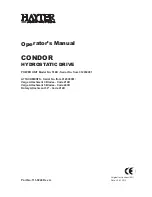
2. PREPARATION
1.
Never use the engine and machine until you
have read and completely understand this
manual, the Engine Operator's Manual and
each of the Safety Messages found on the
safety signs on the engine and machine.
2. Personal pro-
tection equip-
ment including
hard hat, safety
glasses, safety
shoes, and
gloves are rec-
ommended dur-
ing assembly,
installation, operation, adjustment, maintain-
ing, repairing, removal, cleaning, or moving
the unit. Do not allow long hair, loose fitting
clothing or jewellery to be around equipment.
3.
PROLONGED EXPOSURE
TO LOUD NOISE MAY
CAUSE PERMANENT
HEARING LOSS!
Power equipment with or
without equipment attached
can often be noisy enough
to cause permanent, partial
hearing loss. We recommend that you wear
hearing protection on a full-time basis if the
noise in the Operator's position exceeds 80db.
Noise over 85db on a long-term basis can
cause severe hearing loss. Noise over 90db
adjacent to the Operator over a long-term ba-
sis may cause permanent, total hearing loss.
NOTE:
Hearing loss from loud noise (from
tractors, chain saws, radios, and other such
sources close to the ear) is cumulative over a
lifetime without hope of natural recovery.
4. Clear working area of stones, branches or
hidden obstacles that might be hooked or
snagged, causing injury or damage.
5. Use only in daylight or good artificial light.
6. Be sure machine is properly positioned, ad-
justed and in good operating condition.
7. Ensure that all safety shielding and safety
signs are properly installed and in good condi-
tion.
2. MAINTENANCE SAFETY
1.
Good maintenance is your responsibility. Poor
maintenance is an invitation to trouble.
2. Follow good shop practices.
- Keep service
area clean and
dry.
- Be sure electrical
outlets and tools
are properly
grounded.
- Use adequate
light for the job at
hand.
3. Make sure there is
plenty of ventilation. Never operate the en-
gine of the towing vehicle in a closed building.
The exhaust fumes may cause asphyxiation.
4. Before working on this machine, shut off the
engine and turn fuel valve off.
5. Never work under equipment unless it is
blocked securely.
6. Always use personal protection devices such
as eye, hand and hearing protectors, when
performing any service or maintenance work.
7. Where replacement parts are necessary for
periodic maintenance and servicing, genuine
factory replacement parts must be used to
restore your equipment to original specifica
-
tions. The manufacturer will not be responsi-
ble for injuries or damages caused by use of
unapproved parts and/or accessories.
8. A fire extinguisher and first aid kit should be
kept readily
accessible while
performing main-
tenance on this
equipment.
9. Periodically tighten all bolts,
nuts and screws and check that all electrical
and fuel connections are properly secured to
ensure unit is in a safe condition.
10. When completing a maintenance or service
function, make sure all safety shields and
devices are installed before placing unit in
service.







































